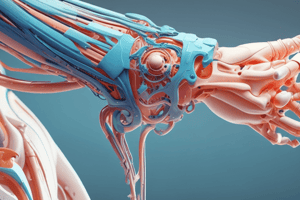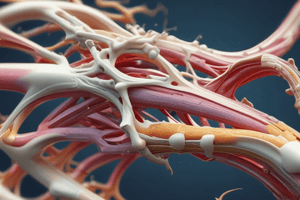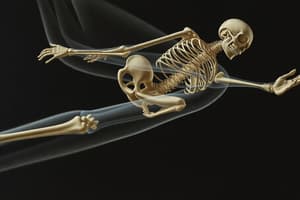Podcast
Questions and Answers
A 2D motion can occur around three axes such as x, y, and z.
A 2D motion can occur around three axes such as x, y, and z.
False (B)
A completely unconstrained segment has 6 degrees of freedom available.
A completely unconstrained segment has 6 degrees of freedom available.
True (A)
Flexion and extension occur in the frontal plane around a sagittal axis.
Flexion and extension occur in the frontal plane around a sagittal axis.
False (B)
Arthrokinematics involves the three anatomical rotations of the human body.
Arthrokinematics involves the three anatomical rotations of the human body.
The direction of segmental rotation in flexion brings dorsal surfaces of adjacent segments closer together.
The direction of segmental rotation in flexion brings dorsal surfaces of adjacent segments closer together.
Displacement measures the linear distance a body moves from its starting position to its ending position regardless of the path taken.
Displacement measures the linear distance a body moves from its starting position to its ending position regardless of the path taken.
Velocity is a scalar measure that describes the time rate of displacement without considering direction.
Velocity is a scalar measure that describes the time rate of displacement without considering direction.
Rolling, sliding, and spinning are all types of movements that occur in joints.
Rolling, sliding, and spinning are all types of movements that occur in joints.
Angular displacement measures the number of degrees or radians of rotation, such as a knee flexed through an angular rotation of 40 degrees.
Angular displacement measures the number of degrees or radians of rotation, such as a knee flexed through an angular rotation of 40 degrees.
Compression is classified as an accessory motion that does not affect joint movement.
Compression is classified as an accessory motion that does not affect joint movement.
The frontal axis runs from anterior to posterior.
The frontal axis runs from anterior to posterior.
Sagittal axis movements commonly include flexion and extension.
Sagittal axis movements commonly include flexion and extension.
The long axis is oriented vertically and allows for external rotation movements.
The long axis is oriented vertically and allows for external rotation movements.
Osteokinematics refers to movements that occur within the joint and cannot be performed voluntarily by the patient.
Osteokinematics refers to movements that occur within the joint and cannot be performed voluntarily by the patient.
Component motions are always under voluntary control.
Component motions are always under voluntary control.
Joint play refers to the passive movements that can be demonstrated but not performed actively by the patient.
Joint play refers to the passive movements that can be demonstrated but not performed actively by the patient.
The frontal axis is at a right angle to the sagittal plane of motion.
The frontal axis is at a right angle to the sagittal plane of motion.
Internal rotation is a common movement associated with the sagittal axis.
Internal rotation is a common movement associated with the sagittal axis.
A body rotates about a single axis of rotation.
A body rotates about a single axis of rotation.
General motion in living organisms involves only linear motions.
General motion in living organisms involves only linear motions.
Kinematics focuses on the forces that produce or change motion.
Kinematics focuses on the forces that produce or change motion.
Statically balanced forces in a body mean that the sum of forces is not equal to zero.
Statically balanced forces in a body mean that the sum of forces is not equal to zero.
Dynamics deals with systems where forces are balanced.
Dynamics deals with systems where forces are balanced.
Kinematic variables can only be assessed qualitatively.
Kinematic variables can only be assessed qualitatively.
Velocity is defined as the rate of change of acceleration.
Velocity is defined as the rate of change of acceleration.
Force is a scalar quantity that only has magnitude.
Force is a scalar quantity that only has magnitude.
External mechanics are defined as factors that produce movement from inside the body.
External mechanics are defined as factors that produce movement from inside the body.
Muscle contraction is a part of internal mechanics that controls movement.
Muscle contraction is a part of internal mechanics that controls movement.
Displacement is a scalar quantity and measures how far the body has moved.
Displacement is a scalar quantity and measures how far the body has moved.
Angular velocity is expressed in meters per second (m/sec).
Angular velocity is expressed in meters per second (m/sec).
Speed is a vector measure of displacement per unit time that includes direction.
Speed is a vector measure of displacement per unit time that includes direction.
Acceleration is defined as the rate of change of distance with respect to time.
Acceleration is defined as the rate of change of distance with respect to time.
A three-dimensional motion analysis system can document changes in displacement over time.
A three-dimensional motion analysis system can document changes in displacement over time.
Kinematic analysis involves studying the motion of objects without considering the forces acting on them.
Kinematic analysis involves studying the motion of objects without considering the forces acting on them.
The rate of displacement is defined as the total distance traveled divided by the time taken.
The rate of displacement is defined as the total distance traveled divided by the time taken.
Distance measures the final change in position from the starting to the ending position.
Distance measures the final change in position from the starting to the ending position.
An electrogoniometer is used to measure the magnitude of joint motion.
An electrogoniometer is used to measure the magnitude of joint motion.
The final change in position is referred to as vector distance.
The final change in position is referred to as vector distance.
Weight is calculated using the formula W = (mass)(gravity) where gravity is approximately 9.81 m/sec2.
Weight is calculated using the formula W = (mass)(gravity) where gravity is approximately 9.81 m/sec2.
The unit of force is expressed in kilograms per meter per second squared (kg/m/sec2).
The unit of force is expressed in kilograms per meter per second squared (kg/m/sec2).
Internal forces are generated from external sources, such as gravity and wind.
Internal forces are generated from external sources, such as gravity and wind.
A force induces acceleration of the object proportional to the mass of that object, as defined by the equation F = (m)(a).
A force induces acceleration of the object proportional to the mass of that object, as defined by the equation F = (m)(a).
Gravity acts on an object's center of mass, impacting the net force vector applied.
Gravity acts on an object's center of mass, impacting the net force vector applied.
The push and pull of wind on an athlete's body is categorized as an internal force.
The push and pull of wind on an athlete's body is categorized as an internal force.
In angular movement, the moment of inertia represents the resistance to a change in linear motion.
In angular movement, the moment of inertia represents the resistance to a change in linear motion.
An idealized force vector represents the net effect of all individual force vectors acting on an object.
An idealized force vector represents the net effect of all individual force vectors acting on an object.
Flashcards
Angular Motion
Angular Motion
Motion of a body about an axis of rotation. A body can rotate around many different axes.
General Motion
General Motion
Combining linear and angular motions. Most movements in living organisms are general.
Kinematics
Kinematics
Describing movement without considering the forces that cause it. Focuses on things like time, displacement, speed, and direction.
Kinetics
Kinetics
Signup and view all the flashcards
Statics
Statics
Signup and view all the flashcards
Dynamics
Dynamics
Signup and view all the flashcards
Biomechanics
Biomechanics
Signup and view all the flashcards
Vector Quantity
Vector Quantity
Signup and view all the flashcards
Scalar Quantity
Scalar Quantity
Signup and view all the flashcards
Internal Mechanics
Internal Mechanics
Signup and view all the flashcards
2D motion of a body segment
2D motion of a body segment
Signup and view all the flashcards
3D motion of a body segment
3D motion of a body segment
Signup and view all the flashcards
Degrees of Freedom (DOF)
Degrees of Freedom (DOF)
Signup and view all the flashcards
Osteokinematics
Osteokinematics
Signup and view all the flashcards
Flexion/Extension
Flexion/Extension
Signup and view all the flashcards
Frontal Axis
Frontal Axis
Signup and view all the flashcards
Sagittal Axis
Sagittal Axis
Signup and view all the flashcards
Long/Vertical Axis
Long/Vertical Axis
Signup and view all the flashcards
Arthrokinematics
Arthrokinematics
Signup and view all the flashcards
Component Motions
Component Motions
Signup and view all the flashcards
Joint Play
Joint Play
Signup and view all the flashcards
Range of Motion (ROM)
Range of Motion (ROM)
Signup and view all the flashcards
Rolling Motion
Rolling Motion
Signup and view all the flashcards
Sliding Motion
Sliding Motion
Signup and view all the flashcards
Spinning Motion
Spinning Motion
Signup and view all the flashcards
What is displacement in biomechanics?
What is displacement in biomechanics?
Signup and view all the flashcards
What is the difference between speed and velocity?
What is the difference between speed and velocity?
Signup and view all the flashcards
What does goniometry measure?
What does goniometry measure?
Signup and view all the flashcards
What is displacement?
What is displacement?
Signup and view all the flashcards
Distance vs. Displacement
Distance vs. Displacement
Signup and view all the flashcards
What is velocity?
What is velocity?
Signup and view all the flashcards
What is angular displacement?
What is angular displacement?
Signup and view all the flashcards
What is speed?
What is speed?
Signup and view all the flashcards
What is acceleration?
What is acceleration?
Signup and view all the flashcards
What is angular velocity?
What is angular velocity?
Signup and view all the flashcards
What is linear velocity?
What is linear velocity?
Signup and view all the flashcards
Linear acceleration vs. Angular acceleration
Linear acceleration vs. Angular acceleration
Signup and view all the flashcards
Inertia
Inertia
Signup and view all the flashcards
Moment of Inertia
Moment of Inertia
Signup and view all the flashcards
Force
Force
Signup and view all the flashcards
What is the equation for force?
What is the equation for force?
Signup and view all the flashcards
Gravity
Gravity
Signup and view all the flashcards
Weight
Weight
Signup and view all the flashcards
Internal Forces
Internal Forces
Signup and view all the flashcards
External Forces
External Forces
Signup and view all the flashcards
Study Notes
Biomechanics Overview
- Biomechanics is the study of motion and its causes in living tissues (humans and animals).
- It uses conceptual and mathematical tools to understand movement and improve it.
- Professionals use biomechanics to improve movement and make it safer.
- Effective and safest movement patterns, equipment, and exercises are essential to biomechanics.
- Physical educators, coaches, athletic trainers, and physical therapists use biomechanics.
Subtopics of Biomechanics
- Biomechanics: the study of the movement of living things (tissues/systems) using the science of mechanics.
- Mechanics: the study of motion and how forces lead to motion.
- Biomechanics studies the structure, function of biological systems using the methods of mechanics.
- Study of internal and external forces and their effects on the human body.
Orthopedic Biomechanics
- Ortho: adjusting something to be "straight" and correct, especially for children.
- Orthopedic: deals directly with bone treatment and musculoskeletal disorders.
- Study of motion and forces in the human musculoskeletal system.
- Art of correcting and preventing deformities in children.
Areas of Study & Research
- Sport & Exercise Science
- Coaching
- Ergonomic equipment design
- Gait & Locomotion
- Orthopedics - Rehabilitation (Physical & Occupational Therapy)
- Prosthetics and Orthotics
- Motor Control
- Computer Simulation
- Video Games
Subdivisions Focused on Injury Prevention & Rehabilitation
- Exercise & Sport Biomechanics: Improving athletic performance, reducing injuries, identifying risk factors, and developing preventative programs.
- ACL prevention rehabilitation program.
- Study changes in joint biomechanics after injury to develop proper rehabilitation programs.
- Orthopedic biomechanics: Uses artificial limbs, joints, and orthoses to improve functional movement capacity and studies natural & artificial biological tissues.
- Occupational biomechanics (Ergonomics): Focusing on reducing workplace injuries.
- Investigates diverse biological systems (swimming, locomotion).
- Comparative biomechanics: (e.g., swimming in fish, locomotion in apes) and horse and dog racing performance.
- Engineers and occupational therapists design assistive equipment to prevent work-related injuries in a range of professions.
- Prosthetics and artificial limbs aim to match the mechanical properties of the missing limb.
- Orthotics: Correct deformities and positioning, providing assistive devices like canes and walkers.
Key Concepts in Biomechanical Testing
- Biomechanical testing can identify aberrant movement patterns & altered neural strategies caused by injuries.
- These issues may not be readily apparent in standard clinical tests.
- Testing is clinically applicable in predicting potential future injuries.
Movement Types
- Translational (Linear) Motion: Body moves along a straight (rectilinear) or curved (curvilinear) line.
- Rotational Motion: Body rotates around an axis.
- Movement patterns in living organisms are combinations of linear and rotational motion.
- Examples: walking (thigh moving linearly with rotation at hip), basketball (linear to rim with rotation)
Human Movement Mechanics
- Internal Mechanics: Mechanical factors producing movement—muscle contraction and ligaments.
- External Mechanics: Work from outside the body—gravity and trauma.
- Describing vs. identifying factors involved in movement production & control.
Statics & Dynamics
- Statics: Constant state of motion—all forces balanced (ΣF =0).
- Dynamics: Unbalanced forces present (ΣF ≠0), causing objects to alter speed or direction.
Kinematics
- Kinematics: Describes movement without considering the forces causing it.
- Includes aspects of time (speeding up/slowing down/duration) and space (direction, how far , location).
- Variables: Displacement: the change in position, regardless of direction (magnitude/direction)
- Velocity: measure of the rate of change of displacement (magnitude/direction).
- Acceleration: rate of change of velocity (magnitude/direction).
- Speed: scalar equivalent of velocity, representing only magnitude.
- Angular equivalent variables include angular displacement, angular velocity, and angular acceleration.
Kinematics Assessment
- Qualitative: Using observations (good/bad).
- Quantitative: Using numerical data to improve accuracy & precision.
Scalar vs. Vector Quantities
- Vector: Quantities with both magnitude and direction (e.g., force).
- Scalar: Quantities with only magnitude (e.g., distance).
Kinematic Features
- Temporal Kinematics: related to time: providing a measure of duration for a particular event e.g. time in the air during jump, duration of foot contact with ground etc...
- Spatial Characteristics: related to space: location/direction of displacement, type of displacement , magnitude of displacement etc...
Angular Motion
- Angular motion is the movement of an object along a circular path around an axis.
- Force induces linear acceleration, whereas torque induces angular acceleration.
Coordinate Systems
- Coordinate system for body segment analysis.
- 3 axes: x, y, z (or X, Y, Z).
- 6 degrees of freedom for complete descriptions of body motion (3 translational & 3 rotational).
- Anatomical positions: defining points of origin and axes that relate to human body posture. (Coronal, Sagittal, Transverse) planes
Joint Movements
- Osteokinematics: Voluntary movements of a joint. (Flexion, Extension, Abduction, Adduction, Pronation, Supination, Rotation)
- Arthrokinematics or Component Motions: Accessory motions of a joint, important for movement and often not voluntary.
- Joint plays and component movements involve rolling, sliding, and spinning motions of joint surfaces.
Additional Kinematic Measures
- Goniometry: Measuring the magnitude (angle) of movements accurately.
- Motion Analysis Methods: Using video technology to measure range, magnitude, and direction of displacement , velocity, and acceleration. Measures of ROM are included.
Kinetics
- Kinetics focuses on forces that cause motion.
- Linear Kinetics: if force is enough to overcome resistance, movement will be linear.
- Angular Kinetics: Causes angular motion.
- Mass, force, inertia, and torque.
Forces: Internal & External
- Internal forces: Generated by muscles, ligaments, bones, & blood flow.
- External forces: External factors that push or pull on the body (gravity, wind, contact with a surface or another body).
Center of Mass (COM)
- Center of Mass (CoM): Single point representing the body's mass distribution.
- Used to simplify calculations.
- Crucial in analyzing forces acting on body.
- Com acts as balanced point.
Posture Analysis
- Evaluating posture for appropriate or inappropriate alignment.
- Identification of relevant posture-related problems in joints, symmetry, and alignment of hips, shoulders, knees, ankles.
Studying That Suits You
Use AI to generate personalized quizzes and flashcards to suit your learning preferences.




